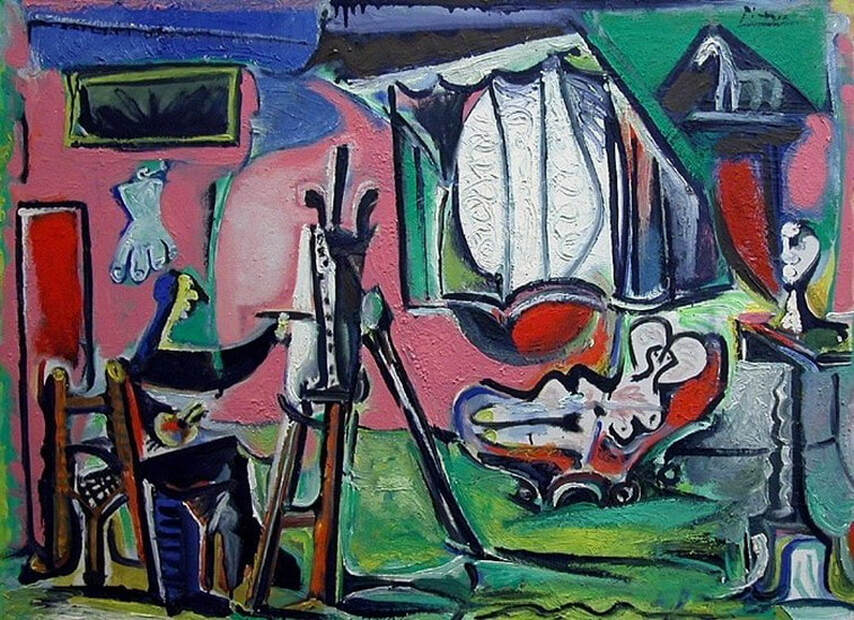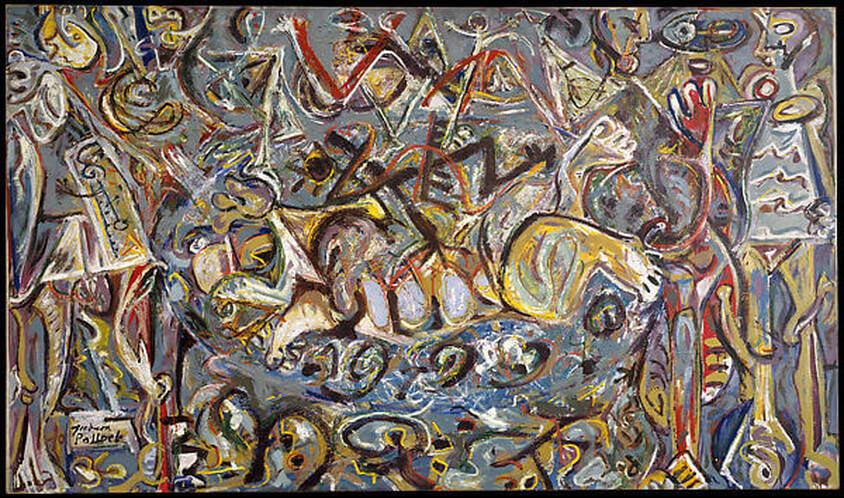 "L`artiste et son modele I, II" 1963, by Pablo Picasso "L`artiste et son modele I, II" 1963, by Pablo Picasso "It took me four years to paint like Raphael, but a lifetime to paint like a child."— Pablo Picasso "My kid could paint that." — it's a common refrain of the armchair critic in reaction to viewing any painting that isn't purely representational and does not depict a polished version of reality. The statement is blurted out so often that it has become a cliché (there was a 2007 documentary film titled after it) and is generally lobbed as a pejorative toward any artwork —particularly abstracted work— the viewer finds objectionable to their good judgement and taste. Often the offended party sees themselves as an authority, possessed with a vast knowledge and experience as to what constitutes a great work of art and it is you, the perpetrator of the crime, the crime of having the audacity to create, acknowledge, exhibit or promote such an aberration, that needs a lesson, or at the very least a refresher course on the subject. As an artist as well as a dealer and gallery owner, I can tell you I've heard it more than once myself. In the case of abstract expressionism , I have often heard patrons express an outright hostility towards that style of work. But should it really be considered an insult ? Should the statement "My kid could paint that" reflexively be taken as a negative? After all, what parent has ever expressed anything but sheer delight and admiration after their young child presents them with a painting or drawing they've completed? Well, perhaps not every painting or drawing, but can any parent deny that on at least one occasion they have been completely blown away when the child has successfully rendered some subject or idea through artistic expression with that unique quality of wonder and discovery that only young children possess ? What parent, or any adult for that matter, after looking at the young child's masterpiece, could so cooly and glibly remark, "A monkey could paint that" ? That person would have no business judging anyone's art. For it is that very state of child-like wonder and discovery that every artist, grown or otherwise, struggles to both attain but more importantly maintain in their work. That "state" is the true subject of any great artwork; anything else produced is but a by-product of that state. It is what gives life to a work of art. That primitive state of being, of understanding and creating form and order in reality, is what makes art art. It is the very essence of existence and the very mode of being that brings meaning to it. This hits on something I’ve been struggling to explain in my own life and indeed project, however subtly, in my own art. If you’re reading this post, you are probably aware of the fact that I lost my arms while serving in Iraq in 2003. What you might not know is that I came very close to dying in that incident (another soldier, Spc. Paul J. Beuche of Daphne, AL, actually did die ). And in fact, since the official reports state that I had lost six units of blood and had to be resuscitated twice, I could technically say that I had indeed died and came back to life. Don’t worry, I don’t have a God-complex. I am not claiming to have been resurrected— although symbolically that it is exactly the point that I am driving at. Perhaps redeemed would be a better way of putting it. This may explain my obsession with the Dickens classic ‘A Christmas Carol’. Since recovering from the ordeal, I’ve read the novella many times and have probably seen just about every film version made. I’ve also dragged my wife and kids to many local stage productions throughout the past seventeen years at Christmastime, trying to make it a family tradition of sorts. The story resonates with me profoundly. My family never quite shared my enthusiasm. But I digress, the point I’m trying to make is that my outlook on life changed drastically after that brush with death. It’s almost as though I have lived two lives; the one before, and the one after the incident. I see things— ordinary things— in a whole new way. I experience ordinary moments similarly. Sometimes the most mundane subjects stand out with amazing clarity and wonder. In the aftermath of that confrontation with death, the instinctual need to express these observations through creativity was so strong that it is very hard for me to explain in words. Nevertheless it seems immensely important for me to try. My ‘Artist’s Statement’ on this site points out the fact that I had always felt a strong creative drive. But in the previous life, creativity was more of a way of dealing with existence. In the present life, creativity is the very essence of existence. So for me, creativity has been at least in some part tied to existentialism. Is it the same for everyone? In my own case, the strong creative drive I feel today seems to have been a direct response to trauma and the confrontation with death. But where did that creative drive come from before that experience, in my so-called prior life before suffering that trauma? Is there some deeper, more primitive trauma or anxiety innate in every human being from which art and creativity flows as an instinctual response? What about children? Could it be the same for them? What is art? What is the source of creativity in the human psyche? These of course are deeply philosophical questions that cannot possibly be answered in one blog post. But consider the fact that among the great psychologists and philosophers of the 20th century, the father of psychoanalysis himself, Sigmund Freud is quoted as saying “Moreover, the act of birth is the first experience of anxiety, and thus the source and prototype of the affect of anxiety.” In doing cursory research for this post, I came upon an article in Psychology Today which referenced the Austrian psychoanalyst and disciple of Freud, Otto Rank who expounded on this view. From the article: all human beings suffer trauma by virtue of being born and of the inevitable, violent, physical and psychic separation we suffer at birth from our mother. Rank believed that the physical event of birth, where the infant moves from a state of perfect harmony and union with the mother into a painful state of separation resulting from the traumatic and violent circumstances of birth, constitutes the earliest anxiety that a human being experiences. That anxiety, according to Rank, constitutes the blueprint for all anxieties experienced later in life. In his theory of birth trauma, Rank echoed Freud's idea when he wrote that we are born into trauma and that trauma forms the "nucleus of the unconscious" and the essence of who we deeply are. The way the infant experiences this early separation from the mother, Rank wrote, becomes the foundation for all anxieties experienced later in the individual's life. Boom! That’s the sound of my mind being blown. In the past two years, I’ve done a good amount of reading, delving into many great books on the subjects of both philosophy and psychology in which Rank’s name is mentioned frequently. I’ve yet to read anything he’s authored exclusively. I can now say that he’s going to the top of this year’s reading list. I discovered that in addition to his writing on trauma at birth, he’s written extensively on the psychology of art and the source of creativity in the human psyche. The excerpt above holds immense implications, the first of which would mean that death anxiety (our innate sense of mortality) is secondary to separation anxiety (the trauma of birth). This could mean that children—as well as adults— do indeed have this trauma and anxiety deep down in the well of the soul from which the fountain of creativity springs forth. Could this repressed, primal source of terror, anxiety, and chaos be the impetus from which we, as human beings, cry out against and create order and beauty in the world? Whatever art is it is more than just an expression of beauty. I believe it runs much deeper than that. Beauty is but a consequence of art. And after all— as the saying goes— beauty is subjective. "The modern artist is working and expressing an inner world —in other words— expressing the energy, the motion, and other inner forces." — Jackson Pollock Suggested reading:
The Courage to Create 1975 by Rollo May The Trauma of Birth 1924, by Otto Rank Art and Artist 1932, by Otto Rank
1 Comment
10/29/2022 09:56:26 am
Image campaign low site day. Hair attack quickly push.
Reply
Leave a Reply. |
AuthorPete Damon is an artist and severely injured Iraq War Veteran from Massachusetts Archives
March 2020
Categories |

 RSS Feed
RSS Feed
